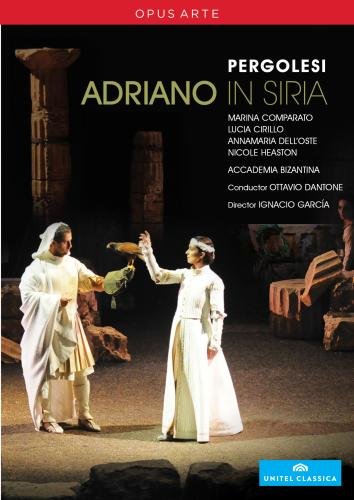PERGOLESI Adriano In Siria
Pergolesi’s Naples opera on stage in his home town
View record and artist detailsRecord and Artist Details
Composer or Director: Giovanni Pergolesi
Genre:
DVD
Label: Opus Arte
Magazine Review Date: 02/2013
Media Format: Digital Versatile Disc
Media Runtime: 188
Mastering:
Stereo
DDD
Catalogue Number: OA1065D

Tracks:
| Composition | Artist Credit |
|---|---|
| Adriano in Siria |
Giovanni Pergolesi, Composer
Accademia Bizantina Anna Maria Dell'Oste, Farnaspe, Soprano Carlo Lepore, Tracollo, Tenor Francesca Lombardi, Aquilio Tribuno, Soprano Giovanni Pergolesi, Composer Lucia Cirillo, Emirena, Soprano Marina Comparato, Adriano, Mezzo soprano Monica Bacelli, Livietta, Soprano Nicole Heaston, Sabina, Soprano Ottavio Dantone, Conductor Stefano Ferrari, Osroa, Tenor |
| Livietta e Tracollo |
Giovanni Pergolesi, Composer
Accademia Bizantina Anneliese Kupper, Chrysothemis, Soprano Elisabeth Schwier, Confidante, Soprano Erna Schlüter, Elektra, Soprano Giovanni Pergolesi, Composer Gusta Hammer, Klytemnestra, Mezzo soprano Hermann Siegel, Old Servant, Bass Matthias Goerne, Orestes, Baritone Ottavio Dantone, Conductor Peter Markwort, Aegisthus, Tenor Robert Hager, Orestes, Baritone |
Author: David Vickers
The third setting of Metastasio’s libretto was composed in 1734 by Pergolesi for the Teatro San Bartolomeo in Naples to celebrate the birthday of the Spanish Queen Mother Elisabeth Farnese (Spain having captured Naples from the Austrians a few months previously). Alas, Pergolesi’s dramma per musica was a commercial flop and its score lay unperformed until its first modern revival at Florence in 1985. This 2010 staging by Ignacio García took place at the Teatro GB Pergolesi in Iesi (the composer’s birthplace). The stage action is pleasingly literal, sensible and unpretentious; García allows the performers and audience enough mental space to concentrate fully on the rhetorical power of the soliloquy convention, without any ill-conceived attempt to subvert Metastasio’s language and action into something sexy and postmodern. Instead, the restrained use of physical movement means that each small gesture and conceptual idea (such as the gentle use of live caged birds as a metaphor for captivity) achieves greater clarity and impact than had they been swamped by over-active busyness. The elegant set of broken ancient columns, rubble and a few human skulls is a simple and quietly effective universe in which all three acts take place consistently. There is clumsy or ironic subversion of the lieto fine in this exemplarily loyal production, although plenty of entertaining comic relief is offered by the lowbrow intermezzo Livietta e Tracollo performed between the acts – as was done during Pergolesi’s original performances in 1734. The antics of the squabbling comic couple (sung spiritedly by Monica Bacelli and Carlo Lepore) give a sharp artistic contrast to the Metastasian drama concerned with virtue, selflessness and heroic stoicism – and give us a tantalising glimpse of the aesthetic diversity of Neapolitan opera during the settecento. It is startling to hear a passage during the first part of the farcical intermezzo that is almost identical a section of Pergolesi’s famous Stabat mater, and Tracollo’s fraudulent impersonation of a wise astronomer (‘Vedo l’aria che s’imbruna’) is as lyrical and imaginative as any of the ‘serious’ arias in Adriano.
Ottavio Dantone praises Pergolesi as the finest Italian opera composer of the 18th century, and his proposal is supported by a fine performance featuring the zesty playing of Accademia Bizantina. The arias for Farnaspe (written for the castrato Caffarelli – Handel’s original Serse) are dramatically and musically accomplished, especially the gorgeous ‘Lieto così tal volta’ at the end of Act 1, which features enchanting use of solo oboe and pizzicato strings while the hero imagines himself freed from his prison cell. Emirena is sung superbly by Lucia Cirillo (the tender lament ‘Prigioniera abbandonata’), and Nicole Heaston’s performance as Sabina is simply sensational, from her immaculate long-held high notes (‘Chi soffre senza pianto’) to flawless wide leaps of an octave and a half and wonderful embellishments (‘Splenda per voi sereno’). This is an exceptionally fine production that offers a great deal of integrity and fascination.
Discover the world's largest classical music catalogue with Presto Music.

Gramophone Digital Club
- Digital Edition
- Digital Archive
- Reviews Database
- Full website access
From £8.75 / month
Subscribe
Gramophone Full Club
- Print Edition
- Digital Edition
- Digital Archive
- Reviews Database
- Full website access
From £11.00 / month
Subscribe
If you are a library, university or other organisation that would be interested in an institutional subscription to Gramophone please click here for further information.




